Maximum Maxim-X |
||||||||||
| ||||||||||
|---|---|---|---|---|---|---|---|---|---|---|
0 |
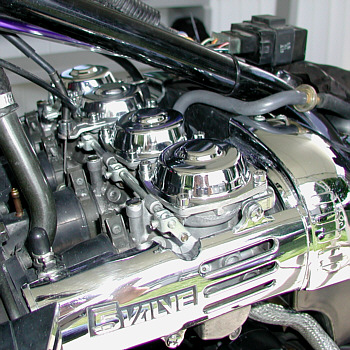 |
OVERVIEW As just about everyone knows, combustion of a fuel:air mixture is just a chemical reaction which we can tinker with. Mixture can be rich (more fuel than required) or lean (more air than required) but the ideal mixture is 14.7 parts air to 1 part fuel. That is known as the stoichiometric balance of fuel:air which results in complete combustion (ie. no extra fuel or air). It's also known that a cold engine requires a richer mixture to combust properly while a hot engine requires a leaner mixture to combust properly. Today's engines are equipped with O2 sensors which constantly measure the amount of oxygen in the exhaust system and use that information to dynamically adjust the fuel:air mixture accordingly. In that way, assuming everything is working as it should, the fuel:air mixture is constantly being adjusted to always try to achieve that stoichiometric balance - theoretically a perfect mixture of fuel and air. But our XJs aren't "today's engines". The Maxim-X (born in 1985) is 27 years old as of 2012. It comes from an era where O2 sensors weren't used as commonly as today, let alone in motorcycles. So where the Maxim-X is concerned, we have to set the fuel:air mixture to one particular "sweet spot" at which it will remain until the next time we tinker with it. The question is.... where is that spot and how do we find it? In my experience, I have noted that the Maxim-X is very particular about mxiture settings. It's not forgiving at all. In fact, I have likened a proper tuneup of a Maxim-X to balancing a ball at the crest of a hill - with some patience and determination you can get the ball to stay but the tiniest of nudges and that balance is lost. While we can easily equalize intake vacuum levels with a Vacuum Sync Gauge, getting the mixture just right is a bit trickier and can be achieved in one (or more) of 7 different ways. |
||||||||
1 |
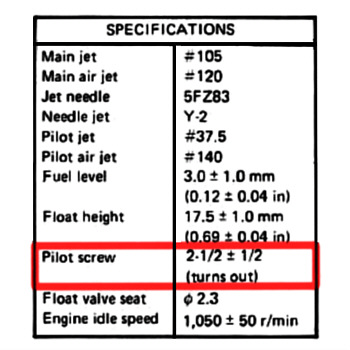 |
FACTORY SPECIFICATIONS The usual place to start is the factory pilot screw settings... but that's only a place to start. Shops often lookup the specifications and simply set the mixture accordingly with no further consideration. If you think you're getting a thorough and proper tuneup when you bring your X to a shop for service, you probably aren't. Many shops simply abandon current pilot screw settings (regardless of WHY they were where they were) and turn the screws to their factory base setting of 2½ turns out from seated for all carbs and stop there. Assuming your carburetor's parts are all intact and the carburetors are clean, that wouldn't be TOO far off.... but it's only a coarse setting at best which is why Yamaha even allowed for a range as indicated by the "+/- ½". In any case, the beginning point is often accepted as 2½ turns out, but things change. Diaphragms stiffen, springs relax, piston bores get scratched, o-rings shrink, etc.... The passage of time alone necessitates a change from that commonly used base setting. In my experience, nowadays most Maxim-Xs seem to do better when you start by setting the pilot screws at 2¾ to 3 turns from seated. That's still within factory specifications and usually gives better results than 2½ turns but it's also still just a coarse mixture setting... closer maybe, but still not quite right. Nevertheless, the factory mixture setting is a reasonably good place to start and sometimes it's even right on.... but not too often. |
||||||||
2 |
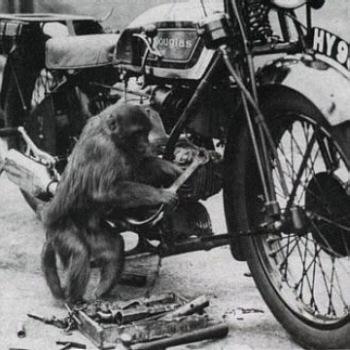 |
BY FEEL Yes indeed.... some people will make their fuel:air mixture adjustments by feel. Hey, who knows? Some people are pretty good at that sort of thing. They can sense even the smallest differences in performance and somehow manage to get the mixture close to right..... but again, it's just close at best. If you think your mixture is bang on by feel alone, you're deluding yourself. It's a guess - maybe an educated one but still a guess. And since the X is so unforgiving and demands attention to detail, if you do it this way there will always be room for improvement!. Take the time and invest the energy to set your Maxim-X fuel:air mixture more than simply by feel - you will be surprised how significant the proper mixture setting can be. |
||||||||
3 |
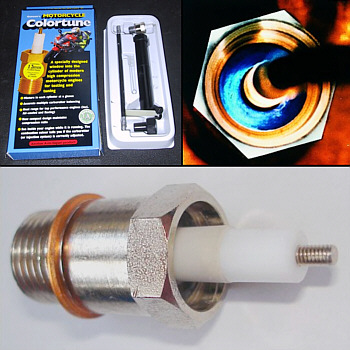 |
COLORTUNE PLUG For those who have never heard of this before, Gunson's makes a glass-top spark plug which allows you to look right into your combustion chamber to see what's going on with the flame. The color of the flame indicates whether the fuel:air mixture is rich (orange), lean (dark blue) or bang on (Bunsen burner blue). This tool is a MUST in the toolbox of Maxim-X owners and indeed other XJ owners as well. There's nothing quite as revealing as actually seeing the flame of combustion - it's about as direct as you're going to get. However, as much as I profess that it's an essential tool to own, using it is a bit more of an art than a science. What looks orange to one person looks yellow to another. What looks ocean blue to one person looks sky blue to another. And, lest we forget, some people are entirely colour blind. The bottom line is that properly using a Colortune plug takes some visual acuity and some practice. After you've done it many times and you both see and feel the results, you begin to get experience that leads to mental adjustments. Personally, I use the Colortune Plug as an intermediate step rather than a final measure.... but maybe I'm not as good at it as the next guy. Still, learning curve or not, the Gunson's Colortune plug will often reveal things about your fuel:air mixture that you weren't previously aware of. Example: Some people are completely unable to lean out their mixture and tend to see an orange flame virtually all of the time. Even if you can't distinguish colours to the sort of degree that the Colortune Plug requires, finding something like a perpertually rich mixture can't help but lead you in other directions and to other solutions. So even if you can't achieve pinpoint accuracy with a Colortune Plug it's still essential to identify broader problems for those who aren't as experienced in its use. |
||||||||
4 |
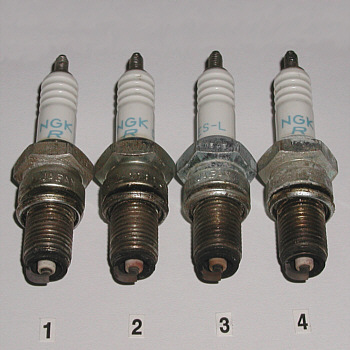 |
SPARK PLUG COLOUR A common method for checking whether your fuel:air mixture is correct is to remove the spark plugs and examine the centre electrode. The idea is to achieve a "tan" colour on and around the centre electrode. If you find more grey or white than you do tan, your mixture is usually too lean. If you find more black than tan, your mixture is usually too rich. It's certainly helpful but it's also very subjective. Once again we're looking for degrees of colours. You could easily see a tan colour but still need to be a touch richer or a tad leaner. And there are also a lot of other factors that can interfere with a proper spark plug reading, like the RPMs you ran at before checking or the temperature of the engine, etc. In fact, sometimes a LEAN mixture can lead to sooty plugs so it's not very precise to say the least. But, like the Colortune Plug easily shows you when the mixture is rich, the appearance of the spark plugs can easily determine whether you're in the ball park. And once you're in the ballpark, someone with a discerning eye will have the ability to tweak mixtures a little here and a little there until they're pretty darn close. Take for example the adjacent picture of the spark plugs as they were years ago in my own Maxim-X. Based on what I see there, I would adjust #1 - 3/8 of a turn richer, #2 - 1/8 of a turn richer, #4 - 1/4 of a turn richer, and I'd leave #3 exactly as is. Then, after riding like that for some time I'd check it again and see whether any additional adjustments were necessary. It's a good way to get a fairly good mixture setting but unfortunately, some spark plugs (like iridium plugs) don't tend to show the expected electrode colours so this method has its problems and inaccuracies too. |
||||||||
5 |
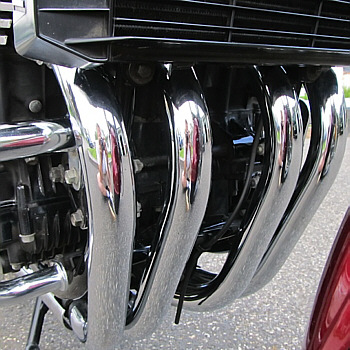 |
DOWNPIPE TEMPERATURE A common and very easy way to check the mixture of your carburetors as they relate to each other is by way of the downpipe temperature. The idea is to fire up the engine and then keep feeling the downpipes to see which get hot soonest and which remain cold longest. It won't necessarily tell you that the fuel:air mixture is in the right ballpark but it will certainly help you equalize the mixtures and that in itself is useful. Once you have the pipes all heating up simultaneously, you can then use another means to determine whether all need to be richer, whether all need to be leaner or whether you're right on. It's fast, it's easy and it's surprisingly accurate for the purpose of equalizing mixtures but on its own, this procedure can't actually do anything to set the mixtures to that stoichiometric balance we need to seek. |
||||||||
6 |
 |
BY SMELL Often we use the other methods available to us to equalize mixture settings across the four cylinders of our XJs but we inadvertently end up at a richer/leaner than perfect level. While equal mixtures are certainly good and more important than achieving exactly the right level, equal does not necessarily mean correct. In fact, 9 times out of 10 when we think the mixture setting is correct based on the tools at our disposal, it's still off. That's all but ineveitable since there is no direct method of measuring the fuel:air mixture for each carb or cylinder. However, as simplistic as it sounds, our noses are a very useful tool in more accurately estimating whether the fuel:air mixture is rich or not. Granted, smell is a very subjective method for fine-tuning fuel:air mixtures. We generally can't distinguish a lean mixture setting from a correct mixture setting, but just about everyone can smell a rich mixture even if it's just the tiniest bit rich. In fact, some people even react physically to the presence of uncombusted fuel in the air (ex. sore, red eyes; dizziness; light-headedness; etc...). So, after you've done all you intend to do to refine mixture settings, THEN, use your nose to tell you whether there is uncombusted fuel in the exhaust at all. If there is, you can simply adjust each carburetor leaner by the same amount. If the adjustments are small at that stage, then the assumption would be that adjusting all the carbs equally wouldn't undo the balance you achieved earlier. Just tweak the carbs equally until you can't smell any fuel anymore and, if your nose knows |
||||||||
7 |
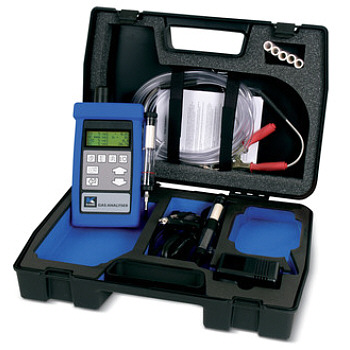 |
EXHAUST GAS ANALYZER In some cases, the use of an exhaust gas analyzer can certainly be an accurate way of determining proper fuel:air mixture.... but not so much for the Maxim-X or other XJs. Since the Maxim-X has four (4) cylinders and only two (2) mufflers connected through an exhaust collector box which combines the exhaust of all four cylinders, there is no way to read the exhaust as it relates to each individual cylinder. As such, an exhaust gas analyzer is of limited use for the Maxim-X in determining or refining mixture settings. However, one way an exhaust gas analyzer could be used is as a more accurate alternative to your nose. After you've done all you intend to do to refine mixture settings, THEN, an exhaust gas analyzer might be able to tell you whether there is uncombusted fuel in the exhaust at all. If there is, you can simply adjust each carburetor leaner by the same amount. If the adjustments are small at that stage, then the assumption would be that adjusting all the carbs equally wouldn't undo the balance you achieved earlier. Adjustments could be made equally again and again until no uncombusted fuel is detected in the exhaust at all. So although an exhaust gas analyzer can't tell you anything about individual carbs or cylinders, it can be used to shift equalized mixtures to achieve expected exhaust output. Who knows, there might even be ways to adapt the use of an exhaust gas analyzer to the exhaust system of the Maxim-X for individual cylinder readings but if something like that exists, I can't imagine it wouldn't be troublesome and costly. |
||||||||
Summary Since the Maxim-X is so finicky where tuning is concerned, it will be worth your while to spend some extra time getting the fuel:air mixture just right. But you won't be able to do it in a single phase unless you're terribly lucky or incredibly talented. None of the methods listed above are sufficient on their own but used together, you'll be able to get the mixture settings as close to perfect as possible. Personally, I recommned the following procedure (assuming the carbs are clean and mechanically sound): a) Factory Specifications - set all pilot screws to 2¾ turns from seated
b) Colortune Plug - achieve Bunsen burner blue combustion flame as near as possible
c) Spark Plug Colour - make small adjustments to achieve uniform "tan" electrode colour
d) Downpipe Temperature - tweak any extreme mixture settings to equalize downpipe warmup temperatures
e) Exhaust Smell - if you smell any fuel in the exhaust at all, adjust each pilot screw equally leaner In the second to final stage you run the risk of diverging from the right mixture settings in order to equalize cylinder performance but there's no reason you can't go back and have another look at the plugs to verify that you're still in the right ballpark. It's also worth having another look with the Colortune plug to try to learn what you should be seeing in the combustion chamber. As long as you're in the right ballpark, having all four mixture settings equalized is much more important than being bang on the right mixture level. Another thing that's worth mentioning is that attempting to synchronize the carburetors before properly setting the mixture will not result in proper synchronization. Similarly, attempting to adjust mixture settings before synchronizing the carbs is equally futile. One depends on the other. Imagine for a moment that #1 carb is excessively rich, #2 and #3 are correct and #4 is excessively lean. In such a case, so-called synchronization is nothing more than equalizing intake vacuum levels to compensate for the badly adjusted mixture. In effect, you'd be unsynchronizing more than anything else. Now imagine that your intake vacuum levels are horribly diverse. That diversity will cause you to misadjust fuel:air mixtures as you try to achieve the visual or tactile results that suggest everything is in balance. Again, you'd only be misadjusting mixtures to compensate for the diverse intake vacuums. The only way to set your mixtures properly or to truly synchronize your carburetors and cylinder performance, is to make all the adjustments at once in small increments until you correctly converge on proper mixture settings and proper synchronization. With most XJs, this sort of attention to detail wouldn't be necessary. You could just set the mixture and sync the carbs and be done.... but not in the case of the Maxim-X. It really is quite finicky. Just the weight of your screwdriver alone can throw off synchronizatin significantly and as little as 1/16th of a turn of a pilot screw can make a noticeable performance difference. So spend the extra time to do it properly and you'll be happy you did. If you're convinced that you don't need to fiddle with your mixture settings, you're probably wrong unless it was recently done (right). Because gummed up carbs directly effect fuel flow, always do a Seafoam treatment or more before you try to fine-tune your fuel:air mixtures. One last thought - before you turn any pilot screws, record the position of each. At least. if you screw something up (no pun intended) you can always restore the pilot screws to their original positions. | ||||||||||